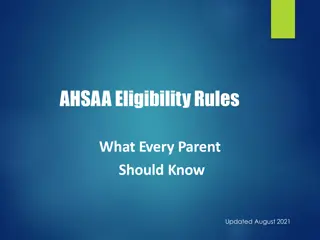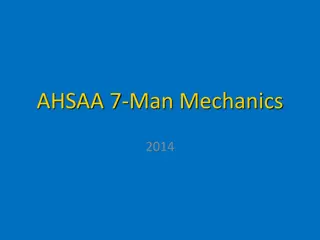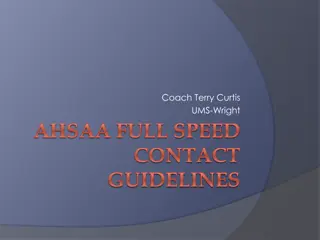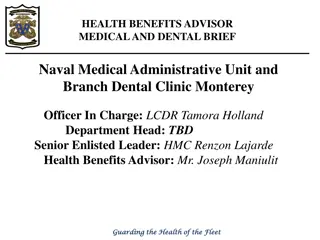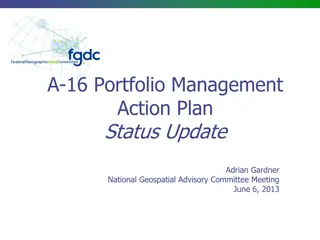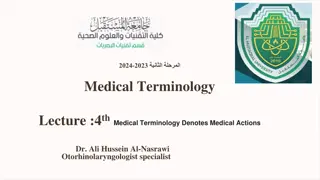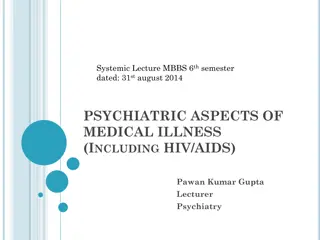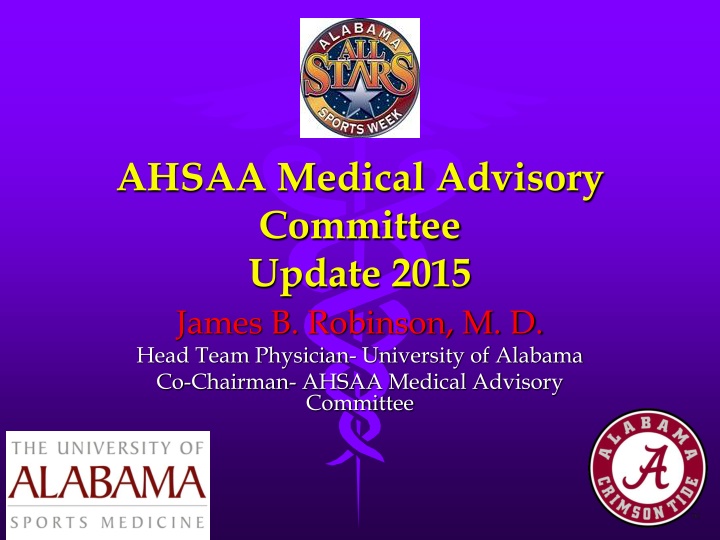
AHSAA Medical Advisory Committee Updates 2015 and Concussion Rules
Learn about the 2015 updates from the AHSAA Medical Advisory Committee, including important information on concussions, contact rules, heat illness, and emergency action plans. Explore Alabama laws and regulations concerning concussions in sports, such as mandatory training and guidelines for coaches, athletes, and parents.
Download Presentation

Please find below an Image/Link to download the presentation.
The content on the website is provided AS IS for your information and personal use only. It may not be sold, licensed, or shared on other websites without obtaining consent from the author. If you encounter any issues during the download, it is possible that the publisher has removed the file from their server.
You are allowed to download the files provided on this website for personal or commercial use, subject to the condition that they are used lawfully. All files are the property of their respective owners.
The content on the website is provided AS IS for your information and personal use only. It may not be sold, licensed, or shared on other websites without obtaining consent from the author.
E N D
Presentation Transcript
AHSAA Medical Advisory Committee Update 2015 James B. Robinson, M. D. Head Team Physician- University of Alabama Co-Chairman- AHSAA Medical Advisory Committee
Important Updates Concussion Contact Rules Heat Illness EAP
Concussion AHSAA concussion rule- 2010 AHSAA mandatory training- 2010 Alabama State Law- Act 2011-541 June 2011, Revised May 2012 Federal Law in the making
HB-308 Section 22-11E-2 of the Code of Alabama 1975 (a) Each local school system and governing body of each sport or recreation organization shall develop guidelines and other pertinent information and forms to inform and educate youth athletes and their parents or guardians in their program of the nature and risk of concussion and brain injury including continuing to play after suspected concussion or brain injury. On a yearly basis, a concussion and head injury information sheet shall be signed and returned by the youth athlete and the athlete s parent or guardian prior to the youth athlete s initiating practice or competition
HB-308 Section 22-11E-2 of the Code of Alabama 1975 (b) Each local school system and sports or recreational organization governing body shall ensure that coaches receive annual training to learn how to recognize the symptoms of a concussion and hoe to seek proper medical treatment for a person suspected of having a concussion.
HB-308 Section 22-11E-2 of the Code of Alabama 1975 (c) Each local school system and sports or recreational organization shall establish by rule the requirements of the training which shall be provided by using designated resources to the extent practicable and timeless to ensure that, to the extent practicable, every coach receives the training before the beginning of practice for the school athletic team.
HB-308 Section 22-11E-2 of the Code of Alabama 1975 (d) A youth athlete who is suspected of sustaining a concussion or brain injury in practice or a game shall be immediately removed from participation and may not return to play the day of the injury and until he or she is evaluated by a licensed physician and receives written clearance to return to play from a licensed physician.
AHSAA Concussion Resources Mandatory Training for ALL coaches Links to NFHS on-line learning via web-site Instructional presentations on web-site
Concussion Make sure all of your coaches have taken the on-line training course Know the signs and symptoms of a concussion Never let an athlete return to practice or game on the same day as injury occurred When in doubt, sit them out Only a licensed MD or DO can clear an athlete for return to play
Football Contact Rules New for 2015 Limits the amount of full contact practice time in an effort to reduce the number of exposures to concussion Some feel that repetitive sub-concussive blows to the head may be detrimental to the youth athlete and lead to future problems
Football Contact Rules Week 1 The first two days of fall practice must be in shorts: Practice time limited to 90 minutes The 3rdday of fall practice may include shoulder pads: Practice time limited to 90 minutes The 4thday of fall practice may also include shoulder pads: Practice time limited to 120 minutes.
Football Contact Rules Week 1 Full football gear/pads can be worn on day 5 (August 7, 2015): Practice time limited to 90 minutes of full-speed contact. Only one practice/day in full pads Two-a-day practices cannot occur on consecutive days There must be at least a 4 hour break between practices on days designated two-a-days
Football Contact Rules Week 2 May alternate days of full-speed contact practice not to exceed 120 minutes of full speed contact per week. One intra-squad scrimmage is allowed
Football Contact Rules Week 3 Alternating days of full-speed contact practice, not to exceed 120 minutes of full contact per week is allowed One intra-squad scrimmage is allowed
Football Contact Rules Week 4 - End of Season A total of 90 minutes of full-speed contact per week is allowed.
Football Contact Rules Full pads may be continued during practice, only full-speed contact is limited. When in shells, no live action, full-speed contact should occur. May participate in : air , bags , wrap , and thud at anytime.
Football Contact Rules Definitions Full Contact: Any simulations in which live action occurs. Live Action: Contact at game speed in which players execute full blocking and tackling at a competitive pace, taking players to the ground. Air: Players run unopposed without bags or opposition
Football Contact Rules Definitions Bags: Activity is executed against a bag or pad to allow soft-contact Wrap: Drills run at full-speed until contact above the waist and players remain on their feet Thud: Any live action or full-speed contact with no pre-determined winner or without taking a player to the ground.
Heat Related Deaths 29 deaths in High School sports from 2000-2009 18 deaths in last 5 years- a record 3rd most common cause of death in High School athletes Usually occurs in first 4 days of practice Death from Exertional Heat Stroke is completely preventable!
EXERTIONAL HEAT STROKE Elevated core temperature ( >104 degrees) associated with signs of organ system failure due to hyperthermia. Total body collapse due to thermoregulatory failure Life threatening! Mortality rates are directly related to time before cooling and length of time core temperature elevated.
EXERTIONAL HEAT STROKE Signs and Symptoms Coma ~ 70% Acute renal failure Rhabdomyolysis Bleeding (DIC) Pancreatitis/ GI bleed Mortality ~ 80% Temperature >104 rectal Fast heart rate Low blood pressure Sweating Rapid breathing Altered mental status Vomiting Diarrhea Seizures
EXERTIONAL HEAT STROKE Treatment Measure rectal temperature Lower temperature as rapidly as possible!! Place in a tub of ice water, remove when temp <102 F (0 fatalities if cooled within 10 minutes) If no ice tubs, place iced towels over entire body and replace every 2-3 minutes 911- to Emergency Room only after cooled!
Treat First Transport Second!! no one should die if proper, prompt, and aggressive care begins within 10 minutes of collapse.
Survival Time 100% survival rate when cooling initiated within 10 minutes
HEAT ILLNESS Prevention Emergency Plan Nearest Emergency facility, transportation, communications, cool tub, rectal thermometer Pre-participation physical exam - identify previous heat related problems Adequate acclimatization = 10-14 days Educate - athletes, coaches, parents Well balanced diet, adequate sleep, avoiding drugs and alcohol
ACCLIMATIZATION Physiologic process by which an individual becomes able to tolerate work in a hot environment. Becoming Thermal efficient Usually takes 10-14 days - maximum acclimatization takes 3 months. Fluid and salt increase heat acclimatization. Exposure to hot environment for 60-90 minutes/day
AHSAA Acclimatization Rule Section 18 The first day of Fall practice is Monday, August 3, 2015. The first two days of fall football practice must be in shorts. Shoulder pads may be worn on day 3 and day 4. These four days are designed for coaches to determine if the students are conditioned physically for football practice. During the first three days of practice, teams are allowed to use hand-held blocking pads. Helmets may be worn from the first day of practice, full pads from the fifth practice day. The earliest date full pads may be worn is August 7. No matter when a student begins fall football practice, that student must practice for three days in shorts before practicing in pads. During two-a-day practices, only one practice per day may be in full pads. The other practice that day can be only in helmets and shoulder pads. No consecutive days of two-a-days practices 4 Hour break between two-a-days practices
HEAT ILLNESS Prevention Weigh athletes before and after practice. a pint s a pound Replace fluid lost during activity. Monitor urine color and volume. Have ice bags available Adequate cold fluids available. Rest periods- adjust for temperature and place in shade if possible. Cool Zone Remove clothing at rest periods, change shirts
FLUIDS Pre-hydration extremely important, if begin dehydrated, will finish worse. Pre-activity weight should be about the same day to day. Monitor urine color and volume. Consume 17-20 oz 2-3 hours prior to activity Consume 7-10 oz 10-20 minutes prior to activity Consume 7-10 oz every 10-20 minutes of activity Post-activity hydration in 2hours Use a urine color chart to determine hydration status NATA Position Statement: Fluid Replacement for Athletes; J Athl Train; 2000;35(2):212-224
FLUIDS Fluids should: Be cool- 50-59 F Contain carbohydrate = <8% , no fructose Contain electrolytes- the more the better Palatable - increases intake by 15% Avoid: Caffeine Energy Drinks Alcohol Carbonated beverages
EAP Emergency Action Plan Each school is responsible for having an EAP that is venue specific EAP must be signed off by principal, athletic director, and medical director if available EAP should be practiced and updated yearly Each coach should have a copy available and located at each venue.







